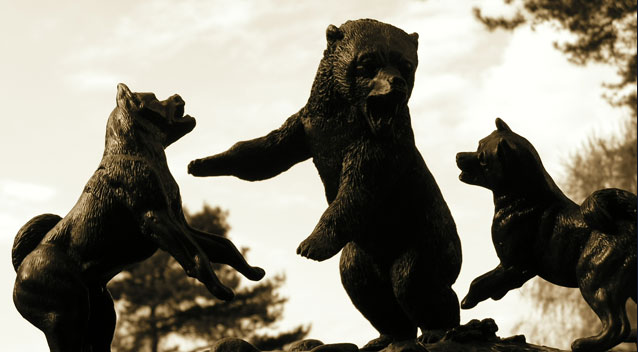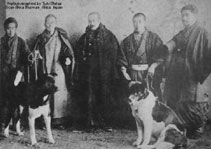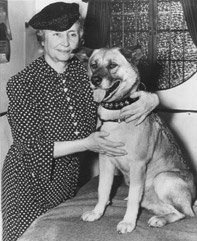- Akita History
- Hachi Ko
- Behaviour and Quality of the Breed
- Training
- Nutrition
- Accoppiamenti
- The Choice of a Puppy
- Wheaning and Growing of a Puppy
- Esposizioni e Toelettatura
- Malattie
- LongCoat Akita
- Bibliography
- Italian Standard
- UK Standard
- American Standard
From prehistory to our days

During the ice-age, the Japan Archipelago ( nowadays: Japan ) was a strip of land. In addition there was an internal sea.
This archipelago was bordered in such a way:
North: Siberian peninsula
South: Korea
During the prehistory period, people were used to move through the natural passage way on the ground.
They moved from Alaska area and through the Siberian peninsula they were able to reach the Japan area.
Obviously, their animals were transferred, too ( dogs, spitz-type ). Some of them were discovered in escavation ( period: 10.000 years ago ).
Then the ice age ended. Consequently the rising of the seas happened. So people met lots of difficulties to move. Finaly, the Japan peninsula was divided into many islands that were separated from the continent. They were exactly as we can see them nowadays.
Because of climate situation of Japan archipelago (in the north there was an artic climate and there was a tropical climate in the south) people found difficulties with their animals from North to South.
A differentiation concerning dogs ( spitz type ) was the biological evaluation consequence: new genetic variations were obtained.
This selection due to the genetic modifications generated homogeneous bloodlines due to the climate conditions and different assignments.
The ancient trade routes developed between Japanese islands and China. The Japanese dogs were crossed with dogs coming from China: from “Chinn” loved by Japanese women to dogs were employed during hawk hunting, till big dogs as Mastiff. Then the business travel concerning the silk market got a remarkable increase in imports from Japan, as far as original dogs from Asia is related too. The crosses of bloodlines were increased thanks to Portugues exchange of dogs.
The Japanese aristocracy bought those dogs. It had been noticed an increased of imports of dogs from West countries. This was recated to the group of mining technicians coming from Europe ( Honshu Island ). In 1800s – 1850s this area was known as “ Prefettura di Akita “. Odate was the capital. It was situated in the mountains and was vary cold.
In that area there was a wild life. There were many animals like wild-boar, bears, elks and so on. Conseguently, the dogs of that area were employed for hunting of so big animals.
During the feudal period there was a wide range of this race of dogs:
- Ji – Inu = coming from the South zone
- Kuriya – Inu= dogs employed for fights
- Matagi – Inu = coming from the mountains ( Matagi means hunter ). They were employed to protect the villages and to help people as sheep dog.
- Tosa Fighting dogs = it was a cross between a Tosa and a Mastiff. Samurai used this dogs for fighting.
- Tibetan Mastiff = It was from Mongolia and it was a cross between Tosa and Mastiff ( from West ).
- In Odate people was used crossing Alani (from West area) and Mastiff (from Mongolia)
Perhaps there were other crosses with San Bernardo race and Bulldogs race.

The period of preservation
 The Japanese were very proud of their nation and with this enthusiasm they entered in a spirit of revaluation of their country.
The Japanese were very proud of their nation and with this enthusiasm they entered in a spirit of revaluation of their country.
They had given an important impulse in a preservation programme as far as dog breeding was concerned. Doctor Shozaburo Watase was a very important exponent of this movement. In 1915 he published an article concerning Japanese dogs.
In 1931 He and his staff reached an important success: the Japanese government declared the big Japanese dog like a national monument. They recognised to this dog the name of Akita ( the first step of selection was made in Akita, a district of Japan ). The committee that was responsible for the preservation of this breed wrote the standard in 1934.
Other breeds were recognised such as: Kai ( Kai Ken), Kishu, Shikoku and Hokkaido.
The second world war
As all the other dog-loving also the Japonese one had very difficult moments during the Second War World.
Above all, especially Akita dogs look as it might be extinguished because of their so big body: Japan had limited stocks of food-stuff and the cost of living was very high.
Moreover the fur was used to make the military uniforms of the Japanese aviators. Furthermore the policy ordered to eliminate all the big dogs, particularly in those of country- economy areas.
This was with the exception of German shepherd because the policy used them to keep the pubblic order. At the end of the war Akita dogs situation was a drama because of only few dogs were alive.
In 1948 an organization named Akita-inu Kyokal took the commitment to project and carry out the first organization wolud be able to protect this breed.
Breed evolution
During the second war a lot of crosses of dogs of Akita with different breeds were made. In particularly it was made with German shepherd. When the Second world war ended a lot of breeders worked in order to obtain this type of Akita as the original dog.
They tried to eliminate all the consequences of past crosses. After this selection there were two type of dogs that was very popular: Kongo – Go and Goromaru – Go.
Kongo-Go was very popular in the dog exhibitions and its blood-line was very well published. It was nicknamed Kurogama or “ sesame” because of the colour described as shaded black or black with brown undercoat.
Between two periods, 1800s and first years of 1900s several crosses were developed between 2 groups: Akita group and dogs of other races group ( Tosa fighting-dogs and Mastiff coming from Europe.
This produced a situation where different bloodlines lived together.
So the breeders were compelled to begin the breed of dogs Ichonoseki bloodline in order to eliminate the characters of Kurogama line. From this operation they obtained the bloodline Goromaru Go.
Those dogs were red motted with a black muzzle mask. In America the develop of the race had its beginning from the Kongo lines.
Akita in America
 Mrs Helen Keller had a very important role in the introduction of this wonderful race into America.
Mrs Helen Keller had a very important role in the introduction of this wonderful race into America.
Before the Second World War, in 1937, Mrs. Keller visited Japan for human matters. So she had been known Hachi-Ko history she asked to meet some dogs of that race. Immediately after, she got as a present a puppy of Kamikaze-Go from Mr Ogosawara who was a member of the police of Akita area.
Mrs Keller came back to the States but, unfortunately, the puppy died. She was in loved of this race by then and she bought the brother of her first puppy that had a long life living with Mrs Keller.
During the Second War Japan was occuped. Some soldiers appreciated the dogs, their beauty and their character, and some of them bought puppies before their coming back.
In 1956 thirty breeders constituted the Akita club.
In 1960 this establishment changed its name in Akita Club of America (www.akitaclub.org).
In 1055 a standard of this race for the USA had been published. All this was realized by some American breeders in co-operation with the manager of Japan Kennel Club.
An order of 1ST January 1956 was signed by American Club to admitted American Akita to partecipate to dogs exhibition.
The first Akita dog that was able to win in the miscellaneous class was Fisher’s Homare Maiku-Go (Orange Empire dog club show – Jenuary 1956).
After a long period, in 1972, the Akita race was registered in the American Kennel Club.

